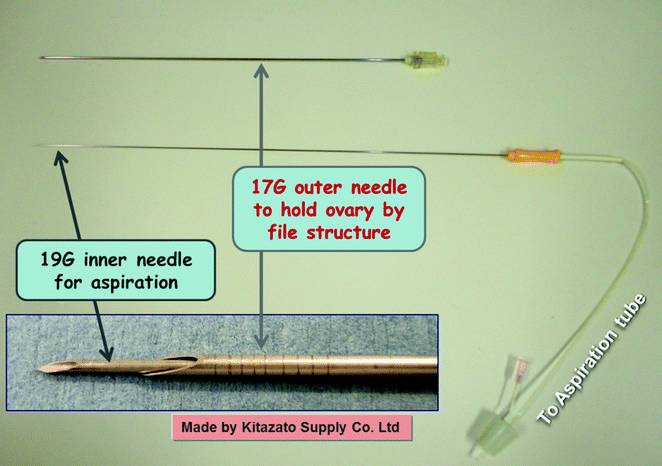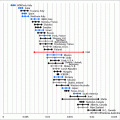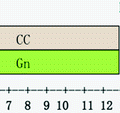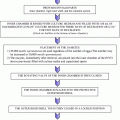Fig. 24.1
IVM protocols at IVF Osaka Clinic. Fresh or frozen IVM are applied depending on the thickness of endometrium on the day of HCG administration
Appropriate Timing for Retrieval
Although the main purpose of this chapter is to explain the techniques of oocyte retrieval, it is imperative for deciding the retrieval date to know the proper timing for IVM-OR. We use frozen cycle in the case of thin endometrium <8 mm on the day of HCG administration as shown in Fig. 24.1. We evaluated the most appropriate timing for IVM-ORs in either fresh or frozen cycles as shown in Fig. 24.2. Appropriate cycle day for IVM-ORs are day 15.4 for fresh cycle and day 13.6 for frozen cycle. However, PCO patients have wide range of menstrual cycle days. Therefore, we determined appropriate cycle day for retrieval by the percentage of individual patient menstrual cycle length. From our study, it shows that 33 or 29% of cycle length is appropriate for retrievals in fresh or frozen cycle, respectively.
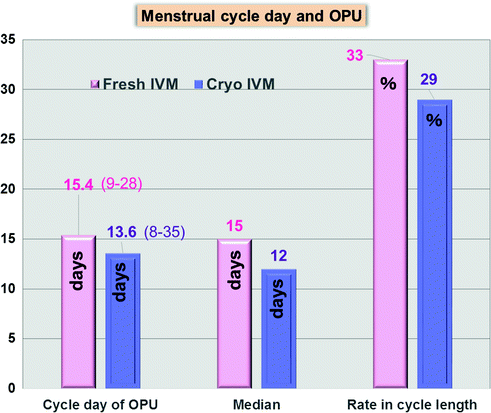

Fig. 24.2
Appropriate timing for IVM oocyte retrievals in either fresh or frozen cycles
Anesthesia for Oocyte Retrieval
Types of anesthesia used for transvaginal follicle aspiration for IVM include iv sedation, local injection, or no-anesthesia at all, but no-anesthesia is not recommended for IVM-OR due to the length of retrieval time. The use of iv sedation for IVM as well as IVF calls for the placement of a secure and accessible venous line. This is necessary not only to administer the medications but also to counteract any side effects using antagonists and to provide fluids in case of needle injury leading to hemorrhage. The use of pulse oximetry is an important part of monitoring patients during iv sedation. The use of low-flow nasal oxygen diminishes or prevents hypoxia during iv sedation. When opioids and benzodiazepines are given concomitantly, the opioid is administered first in a therapeutic dose, followed by the benzodiazepine, which is titrated to the desired effect. This order is based on the ability of opioids to reduce the required dose of a sedative. Propofol (Diprivan) is an intravenous general anesthetic agent that has a rapid onset of action and a rapid recovery after administration. Induction with propofol frequently causes apnea for >60 s and may require ventilatory support. Equipment for this procedure, including an airway, Ambu bag, and supplemental oxygen, should be readily available. Propofol has no effect on pain threshold and therefore requires the concomitant administration of an analgesic. In addition, propofol frequently causes pain, burning, and stinging at the injection site. The use of larger veins, such as those of the antecubital fossa, and the administration of lidocaine before injection of propofol may minimize pain at the injection site. Local anesthesia is an option for IVM, but can cause unnecessary patient discomfort, because more than several puncture should be done for IVM. A local agent can anesthetize only the vaginal mucosa, not the ovary itself. Anyway, it needs a little longer time of anesthesia for IVM compared to IVF.
Procedure of Oocyte Retrieval
Patients were placed in the dorsal lithotomy position, and the vagina was cleansed with sterilized saline or water without antiseptics. The technique for IVM-OR involves the introduction of a transvaginal ultrasound probe equipped with a needle guide into the vagina. The probe is pushed gently and firmly into the ipsilateral vaginal fornix with the ovary to be aspirated to make an image of aiming ovary as close as possible. Before puncture is initiated, middle-sized vessels in the tissue should be identified by color Doppler to avoid rupturing those vessels on its way to ovary. A needle connected to an aspiration pump is then inserted into the follicles through the vaginal wall and ovarian capsule, while the pump simultaneously applies suction with an aspiration pressure. The number of punctures to the vaginal wall and the ovarian capsule for aspirating should be limited as little as possible to reduce the risk of post-retrieval bleeding, at the same time to retrieve the oocytes as many as possible [5]. The needle tip should be visualized during the entire procedure to avoid injury to adjacent pelvic organs or tissues. IVM-OR is based on the same principle as IVF, but the detail is different. Double-needle system, instead of single needle, is used for IVM-OR to reduce the number of puncture on both vaginal wall and ovarian capsules. To facilitate easier puncturing of small follicles, we developed a new designed needle (IVF OSAKA IVM Needle, Kitazato Medical Co. Ltd., Tokyo, Japan) as shown in Fig. 24.2. Outer needle is 17 gauge with file structure on the tip and used to penetrate the vaginal wall and puncture the ovarian tissue for anchoring there during aspiration (Fig. 24.3). Then, the inner 19-gauge needle is inserted into the outer needle to aspirate small follicles by aspiration pressure of 150 mmHg similar to IVF. However, many other IVM centers use lower pressure compared to IVF. When you finish up aspiration of individual follicle, you should rotate the aspiration needle inside the follicle with continuous negative pressure in order to scrape whole inner surface of the follicle not to leave immature oocyte. You can puncture the most of small follicles located in all areas of the ovary by changing the direction and depth of outer needle without additional puncture. The outer needle together with inner needle is withdrawn after aspiration of all follicles in an ovary, and the procedure is repeated on the contralateral side. However, in IVM-OR, the majority of follicles to be aspirated measure <10 mm in diameter, and the aspiration needle frequently becomes clogged with blood clots and ovarian tissues during procedure. This occurs not only due to the smaller diameter of the aspiration needle (19 gauge) but also tightly connected granulosa cells, when compared to IVF aspiration with larger gauge needle (17 gauge) and loosely connected mature OCC. Therefore, when you feel insufficient aspiration power, the aspiration needle should be withdrawn from the ovary through the outer needle for flushing its lumen before the next aspiration. Double-needle system does not need multiple punctures of the vaginal wall and ovarian capsule during IVM-OR [6–13]. Moreover, the usage of double-needle system can reduce the undesirable failure IVM-OR with no oocyte retrieved as shown in Table 24.1. All-over failure rate is 1.15%, but none of the PCO patients was failed to retrieve oocyte. This concept has been applied to most IVM centers worldwide [14]. The patients are observed in the clinic for a minimum of 1 h after IVM-OR (Figs. 24.4 and 24.5).
